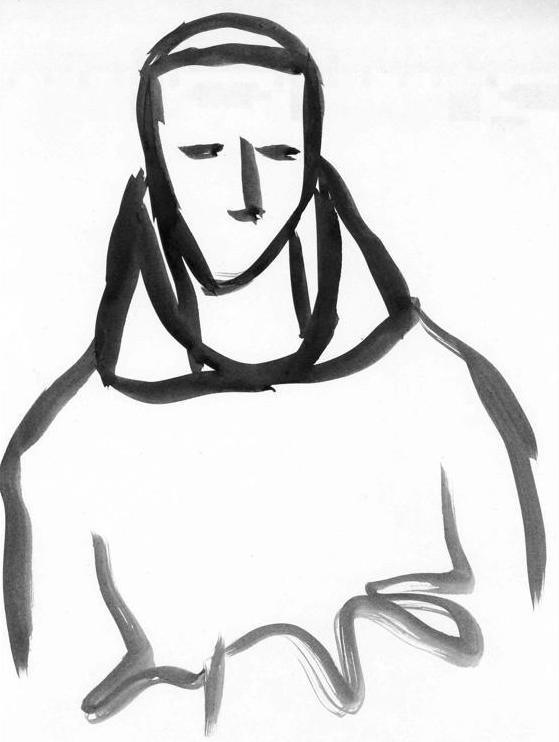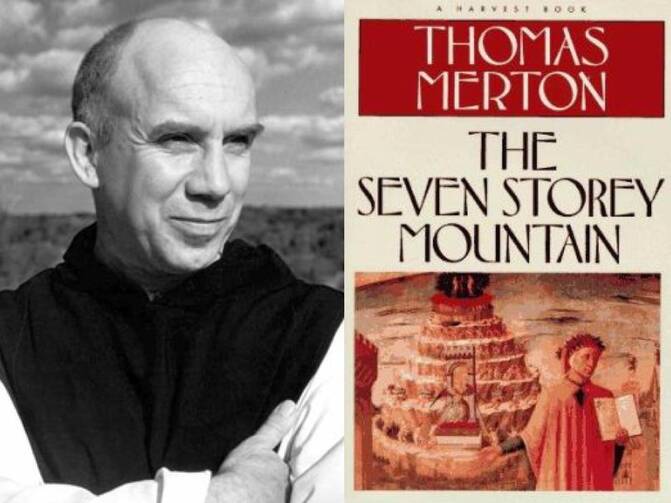Remembering Thomas Merton—and his book that changed my life
I have a simple drawing of a monk at prayer tattooed on my left shoulder. His eyes are closed, with his hands folded under the cowl Trappist monks wear in choir over their habits. The drawing the tattoo artist used was by Thomas Merton, the American Trappist monk best known for his many writings on topics ranging from prayer and contemplation to war and racism, but who also enjoyed dabbling with ink and paper to create small works of art.
I got this tattoo 25 years ago after reading Merton’s acclaimed autobiography, The Seven Storey Mountain, a book whose 75th anniversary is celebrated this month. Although Merton’s publisher expected little in terms of sales—a last-minute additional clause to Merton’s contract stipulated what would happen should sales dip below 500 copies in any six-month period—The Seven Storey Mountain became a publishing phenomenon.
Now widely considered a spiritual classic, The Seven Storey Mountain has never gone out of print, and it continues to find new readers every year.
Exceeding all expectations, it sold 600,000 copies in its first year of publication in 1948. In a world destabilized by the ravages of the Second World War, this story of a young man converting to Catholicism and finding stability within the walls of a Trappist monastery in Kentucky struck a nerve among Catholics and non-Catholics alike. Now widely considered a spiritual classic, The Seven Storey Mountain has never gone out of print, and it continues to find new readers every year.
I was one of those new readers in 1998; I discovered the book when I most needed to read it. After getting married in July of that year, my bride and I moved across Canada from Alberta to Ontario so I could pursue my dream of becoming an academic. I had finished one undergraduate degree and wanted to get another before going to graduate school to become a theologian. But shortly after starting classes, I began to question seriously whether I was actually called to become an academic or if I should pursue another path. I had been so certain about the academic path I was on that my doubts brought about a crisis. What felt like solid ground had ceased to be so.
The Seven Storey Mountain came as a godsend during that crisis. The first half of the book tells the story of Merton’s childhood, adolescence and eventual conversion to Roman Catholicism. This was interesting to me, but it didn’t speak to me as much as the story that Merton recounts in the second half: a story about vocation, about finding meaning and purpose in life.

Not long after his conversion, Merton thought he had a vocation to the priesthood and to monastic life, and he threw himself headlong towards this calling. However, after the Franciscans first accepted and soon after rejected him, a Capuchin priest in the confessional told him that he certainly had no such calling. Merton found himself in crisis. Instead of pursuing the priesthood, Merton went to St. Bonaventure College (now University) in upstate New York to teach and to write, but he was tortured by his continued desire to pursue the priesthood in a contemplative monastery and his belief that God had told him “no.”
Merton’s description of his anguish during this time is heart-wrenching, and when I first read his account of this crisis of vocation, I was breathless. I recognized myself in the turmoil Merton experienced when the vocational ground on which he was standing crumbled. I thought I was supposed to become a theologian—that this was what God was calling me to do. And then, suddenly, I was questioning all of it, wondering if I had directed all my energies toward something that I wasn’t, in fact, supposed to do. Had I dragged my new spouse across the country in pursuit of something I was not called to do? Had I wasted my time and resources, as well as the time and resources of others, on a delusional dream? It was disorienting, to say the least. It was, more accurately, crisis-inducing. I was lost and scared.
Misery loves company. Suffering is isolating, so it can be comforting to have another person who has been through a similar experience accompany us. And this is precisely what Thomas Merton did for me in those days—he accompanied me. His story became intertwined with mine, and he immediately became a companion, even a friend.
As I read through The Seven Storey Mountain, I already knew how Merton’s story would turn out. A kind Franciscan at St. Bonaventure College finally assured Merton that he did indeed have a vocation to the priesthood and religious life, and Merton shortly thereafter left for the Abbey of Gethsemani, where he remained a monk for the rest of his life. Even though I knew the ending, my heart raced as I followed his account of traveling down the road toward the monastery and seeing the Abbey church’s spire. And when he entered the monastery to be enclosed in what he described as “the four walls of my new freedom,” I experienced profound relief on his behalf but also for myself. Surely, I thought, if this man’s vocational crisis could be resolved, then so could mine.
Misery loves company. Suffering is isolating, so it can be comforting to have another person who has been through a similar experience accompany us.
After I read The Seven Storey Mountain, I started reading everything I could by Merton, particularly his private journals, and his writings continued to speak to me on a profound level. I became so taken with him that I got that tattoo of a drawing by Merton.
When I finished graduate school, my vocational crisis was fittingly resolved when I got a position as a theologian at Bellarmine University in Louisville, Ky., the home of the official repository of Merton’s literary estate. Although I have since moved on to another position in a different city, Merton remains a constant companion.
The Seven Storey Mountain is not perfect. It is overly wordy and needed more thorough editing. (The great English Catholic novelist, Evelyn Waugh, liked the book, but was so taken aback by the writing that he sent Merton a book on how to write more effectively). In his early writings, Merton depicts Catholicism in a triumphalist manner that doesn’t reflect his later theological depth of understanding. But these imperfections hardly registered for me when I read it for the first time. Much more important to me was the way in which his experiences spoke to my own—decades after Merton recorded them.
In his 1965 book Conjectures of a Guilty Bystander, Merton wrote, “There are people one meets in books or in life whom one does not merely observe, meet, or know. A deep resonance of one’s entire being is immediately set up with the entire being of the other.” He went on to say that such people end up making a kind of “choir” whose music continues to resonate with one on a deep level. Part of what makes The Seven Storey Mountain a spiritual classic 75 years after its publication is that, despite the book’s flaws, people like myself found in Merton someone who became part of their “choir.”
And I, for one, am grateful for his voice.





No comments:
Post a Comment